By the President of the United States of America
A Proclamation
Whereas section 412 of title 2 of the Canal Zone Code approved June 19, 1934, requires the President to determine the tonnage of vessels upon which toll charges for the use of the Panama Canal shall be based; and
Whereas the act entitled "An Act to provide for the measurement of vessels using the Panama Canal, and for other purposes", approved August 24, 1937, which amends the said section 412 and which by its terms becomes effective March 1, 1938, provides, in part, that tolls on merchant vessels, army and navy transports, colliers, hospital ships, supply ships, and yachts shall be based on net-vessel tons of 100 cubic feet each of actual earning capacity determined in accordance with the Rules for the Measurement of Vessels for the Panama Canal prescribed by the President and as may be modified by him from time to time by proclamation after public hearings and six month's public notice:
Now, Therefore, I, Franklin D. Roosevelt, President of the United States of America, acting under and by virtue of the authority vested in me by the aforesaid section 412 of title 2 of the Canal Zone Code, approved June 19, 1934, do hereby prescribe and proclaim the Rules for the Measurement of Vessels for the Panama Canal which are annexed hereto and made a part of this proclamation.
The Rules for the Measurement of Vessels for the Panama Canal prescribed by this proclamation shall become effective on March 1, 1938, and shall on that date supersede the Rules prescribed by Proclamation No. 1258 of November 21, 1913.
In Witness Whereof, I have hereunto set my hand and caused the seal of the United States to be affixed.
Done at the City of Washington this 25th day of August, in the year of our Lord nineteen hundred and thirty-seven and of the Independence of the United States of America the one hundred and sixty-second.

FRANKLIN D ROOSEVELT
By the President:
CORDELL HULL
Secretary of State.
RULES FOR THE MEASUREMENT OF VESSELS FOR THE PANAMA CANAL
EFFECTIVE MARCH 1, 1938
All Vessels to Present Tonnage Document at Canal
1. Article I. All vessels, American and foreign, except warships, floating dry-docks, and dredges, including vessels of commerce and Army and Navy transports, colliers, supply ships, and hospital ships, applying for passage through the Panama Canal shall present a duly authenticated certificate stating the vessel's gross and net tonnage as determined by these rules. Vessels of commerce, Army and Navy transports, colliers, supply ships, and hospital ships without such certificate shall, before passing through the Canal, or before being allowed to clear therefrom, be measured, and shall have their gross and net tonnage determined in accordance with these rules.
2. All warships, American and foreign, other than transports, colliers, supply and hospital ships, shall present duly authenticated displacement scale and curves stating accurately the tonnage of displacement at each possible mean draft.
Vessels Designated as "Supply Ships", "Colliers", and "Warships"
3. It is to be understood that "supply ships" shall include Army and Navy ammunition ships, refrigerator ships, distilling ships, repair ships and tenders, as well as Army and Navy vessels used to transport general Army and Navy supplies; and that "colliers" shall include Army and Navy vessels used to transport coal or fuel oil; and that "warships" shall include armed coast guard vessels and vessels devoted to naval training purposes.
GROSS TONNAGE
Spaces To Be Included in Gross Tonnage
4. Art. II. Gross tonnage as determined by these rules shall express the total capacity of vessels, i.e., the exact cubical contorts of all spaces below the upper deck and of all permanently covered and closed-in spaces on or above that deck, excepting such spaces as may be hereinafter permitted as exemptions from measurement. Gross tonnage shall include not only all permanently covered and closed-in spaces which are or may be used for stowing cargo and stores or for providing shelter and other comfort for passengers or crew, but also such spaces as are used, or are intended to be used, in navigating and serving the vessel.
5. Only such spaces as are specifically mentioned in article IV, below, shall be exempted from measurement. All other spaces shall be considered as closed in and shall be included in gross tonnage.
Spaces Considered Permanently Covered and Closed-In
6. Art. III. By permanently covered and closed-in spaces on or above the upper deck are to be understood all those which are separated ofl by decks or coverings, or fixed partitions, and which, therefore, represent an increase of capacity that is or may be used for the stowage of cargo, or for the berthing and accommodation of the passengers, the officers, or the crew. No break in a deck, nor any opening or openings in a deck or the covering of a space or in the partitions or walls of a space, nor the absence of a partition shall prevent a space from being measured and comprised in gross tonnage if means are provided for closing such a break, opening or openings, so that the spaces thus closed in be thereby better fitted for the transport of goods or passengers. The upper deck is the uppermost full length deck extending from stem to stern.
7. In the case of a vessel having a "trunk" or "turret", the deck forming the covering of the trunk or turret shall be considered the upper deck, and all spaces below that deck within the trunk or turret shall be considered as covered and closed in. The space within the turret or trunk shall be measured as are other between-deck spaces.
8. Spaces considered as "permanently closed in" and spaces permitted to be exempted from measurement shall be determined solely by the provisions contained in these rules, and not by any definitions or provisions contained in the measurement rules or regulations of any country.
Spaces Exempted From Measurement and Gross Tonnage
9. Art. IV. The following spaces shall be exempted from measurement and shall not be included in the gross tonnage, and no other spaces shall be exempted:
10. SECTION 1. Spaces on or above the upper deck not permanently covered or closed in, or which may not be readily covered or closed in. in the application of this rule it will be understood that—
(a) Spaces under decks or coverings having no other connection with the body of the ship than the stanchions necessary for their support are not spaces separated off, but are spaces permanently exposed to the weather and the sea and are not to be included in the gross tonnage.
(b) A space within a poop, forecastle, bridge house, or other "permanently covered and closed-in" superstructure or erection may be considered as not permanently covered or closed-in, and may consequently be excluded from tonnage, if the space is opposite an end opening which is not provided with means of closing, and which opening has a breadth equal to or greater than half the breadth of the deck at the line of the opening, and if the space opposite the opening cannot be used to shelter other merchandise than cargo or stores that do not require protection from the sea. If the opening is fitted with a coaming, the space within it is to be included in the gross tonnage if the coaming is more than 2 feet in height. This provision shall be so applied as to exempt from measurement only the space between the actual end opening and a line drawn parallel to the line or face of the opening at a distance from the opening equal to one-half the width of the deck at the line of the opening: provided, that any closed-in space between the open face and the line drawn parallel to it shall be measured. The remainder of the space within a poop, forecastle, bridge house, or other superstructure or erection shall be considered as available for the accommodation of cargo or stores, of passengers or of the ship's personnel, and shall be measured and included in the gross tonnage. (See figs. 1, 2, and 3.)
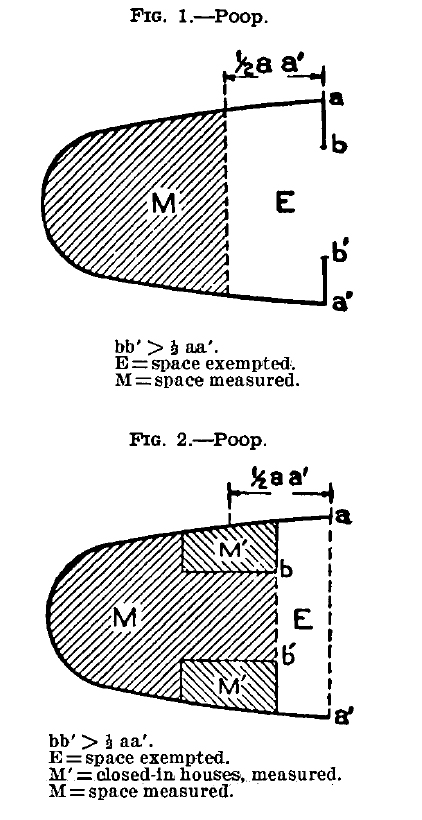
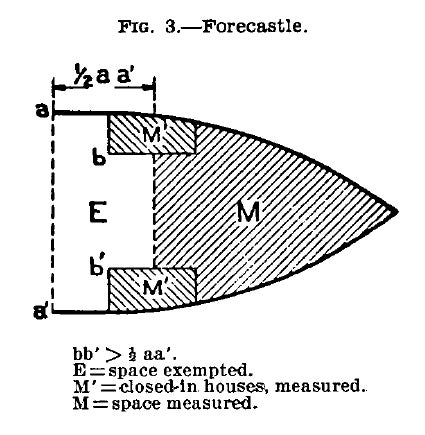
Should the open space within a poop, forecastle, bridge house, superstructure, or erection between the end opening and a parallel line distant from the opening by half the breadth of the deck become, because of any arrangement, except by convergence of fore and aft bulkheads, of less width than half the breadth of the deck, then only the space between the line of the end opening and a parallel line drawn through the point where the athwartship width of the open space within the poop, forecastle, bridge house, superstructure, or erection becomes equal to, or less than, half the breadth of the deck shall be exempted from measurement. (See figs. 4, 5, 6, and 7.) The remainder of the space within the poop, forecastle, bridge house, superstructure, or erection is to be included in the gross tonnage.
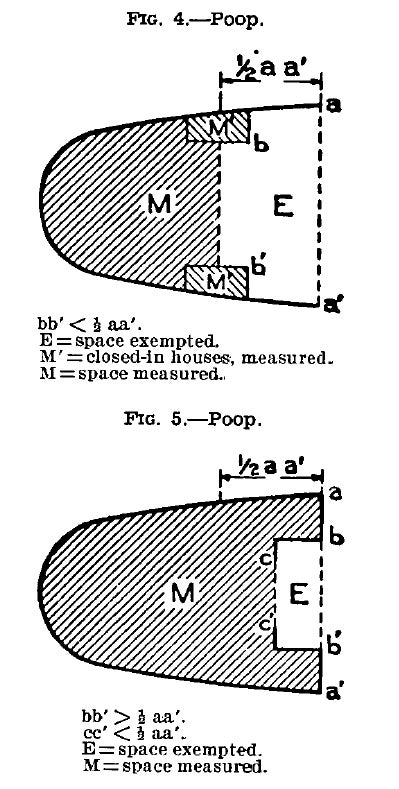
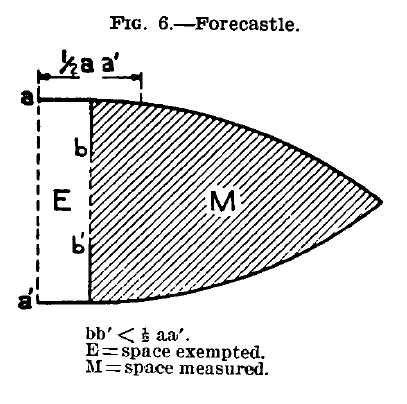
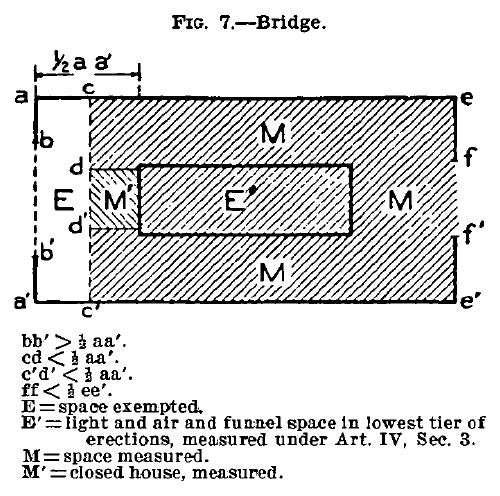
When two erections extending from side to side of the ship are separated by an interval the fore-and-aft length of which is less than the least half breadth of the deck in way of such interval, then whatever be the breadth of the permanent end openings of the erections, the entire erections, less the interval separating them, shall be measured and included in the gross tonnage. (See fig. 8.)
(c) in a poop, forecastle, side-to-side bridge house, or other "permanently covered and closed-in" superstructure or side-to-side erection the space directly in way of opposite openings, the height of which is at least 3 feet, in the side walls of the ship not provided with means of closing and corresponding to each other in the opposite walls of the ship shall be exempted. (See figs. 9 and 10.) Passages running fore-and-aft abreast the engine-room casing and open at both ends shall not be exempted. The deck erection including same shall be considered a side-to-side erection provided its outboard sides are flush with the hull of the vessel.
11. Sec. 2. Spaces in way of opposite side openings at least 3 feet in height not provided with means of closing shall be exempted. in the case of a continuous deck with one or more deck openings (usually designated as tonnage openings) that may be so closed as to permit cargo or stores to be carried in the space under the deck, or under portions thereof, only the spaces under such a deck that are exactly in way of opposite
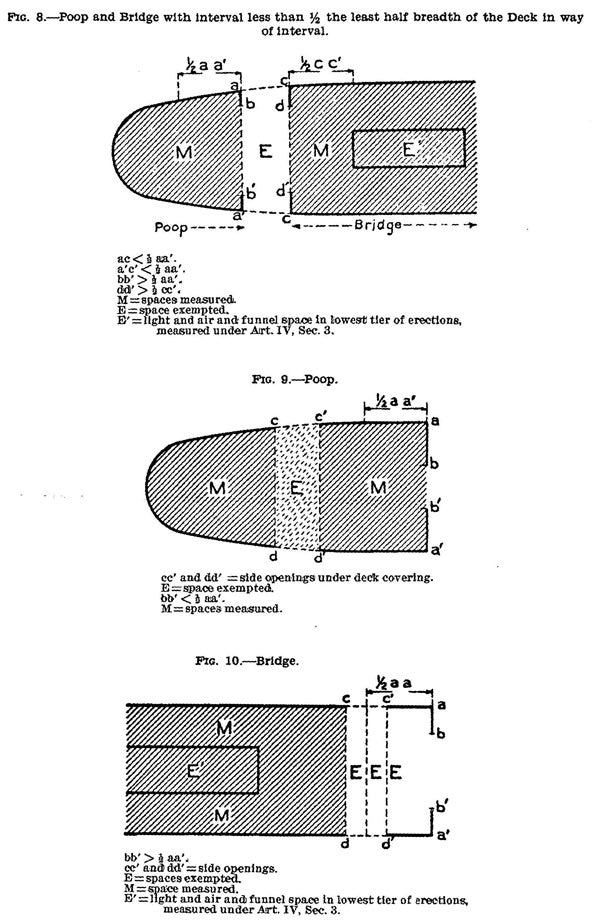
openings at least 3 feet in height in the side walls of the ship not provided with means of closing and corresponding to each other in the opposite walls of the ship shall be exempted; and the remaining spaces under such a deck shall be measured and included in gross tonnage. in case the openings in the side walls of the ship are provided with means of closing no portion of the space under such a deck shall be exempted. (Pig. 11.)
12. Sec. 3. The spaces framed in round the funnels and the spaces required for the admission of light and air into the engine rooms shall be exempted from measurement to the extent that such spaces are above the deck or covering of the first or lowest tier of side-to-side erections, if any, on the upper deck as defined in Art. III. A deck with one or more deck openings (usually designated as tonnage openings) that may be so closed as to permit cargo or stores to be carried in the space under the deck or portions thereof would be considered as the upper deck. There shall, however, be measured and included within gross tonnage the spaces situated within closed-in side-to-side erections on the upper deck, spaces framed in round the funnels and those required for the admission of light and air to the extent that such light and air and funnel spaces are below the deck or covering of the first or lowest tier of such side-to-side erections on the upper deck. There shall be exempted from the measurement of any superstructure or erection situated above the first or lowest tier of side-to-side erections on the upper deck such portion or portions thereof as are occupied by the spaces framed in round the funnels or by the spaces required for the admission of light and air into the engine rooms. Such exempted spaces must not be used for any other than their designated purpose and must be reasonable in extent.
13. Sec. 4. Space or spaces between the inner and outer plating of the double bottom of a vessel shall be exempted from measurement, except when used, designated or intended for carrying cargo; but the tonnage of such spaces within the double bottom as are or may be used for carrying cargo, shall be determined and included in the gross tonnage. The tonnage of double bottom tanks available for cargo may be obtained by multiplying the liquid-capacity weight by the proper conversion factor to get tons of 100 cubic feet.
14. Sec. 5. The cubical contents of hatchways shall be obtained my multiplying the length and breadth together and the product by the mean depth taken from the top of beam to the underside of the hatch cover. From the aggregate tonnage of the hatchways there shall be deducted one-half of 1 percent of the vessel's gross tonnage, exclusive of hatchways, and only the remainder shall be added to the gross tonnage of the ship, exclusive of the tonnage of the hatchways.
15. Sec. 6. Companion houses shall be exempted when used solely to protect stairways and ladders leading to spaces below. When used as smoking rooms or for any other purposes than companion houses, the parts so used shall be measured and included in gross tonnage.
16. Sec. 7. Domes, skylights, and air-shafts shall be exempt from measurement. When there is an opening in the floor of a superstructure immediately below a skylight, the exemption shall include the space between the skylight and the opening in the floor of the superstructure immediately under the skylight. The remainder of the superstructure shall be included in the measurement. The space, in addition to the skylight, that may be exempted by this rule is that indicated by A, B, C, D in the following drawings:
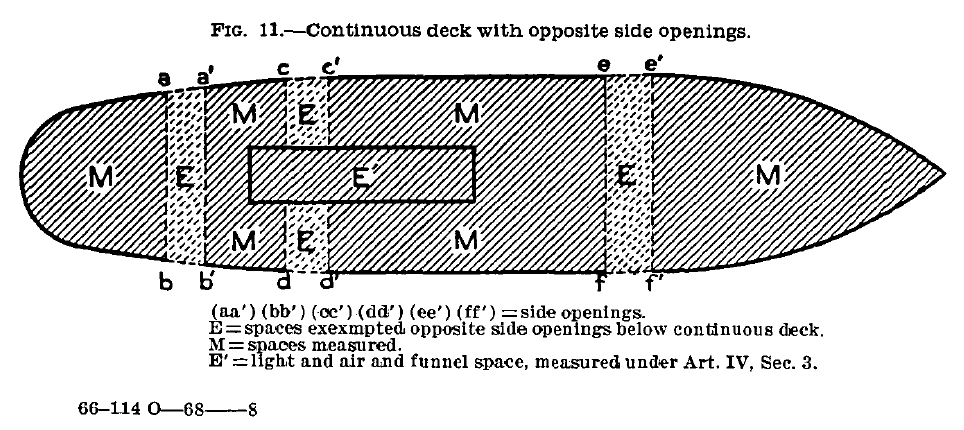

17. Art. V. (This section was eliminated on recommendation of Special Committee on Panama Canal Tolls and Vessel Measurement Rules, 1936.)
Spaces Available for Passengers Not To Be Exempted
18. Art. VI. Spaces for the use or possible use of passengers shall not be exempted from measurement except as stated in Article IV, Section 1, paragraph (a).
19. In case of Army and Navy transports, colliers, supply ships, and hospital ships as defined in article I, the term "passengers" shall include all officers, enlisted men, and other persons who are not assigned to duty and who are not duly inscribed on the ship's rolls.
20. Art. VII. (This section was eliminated on recommendation of Special Committee on Panama Canal Tolls and Vessel Measurement Rules, 1936.)
Measurement of the Cubical Contents of Spaces May Be by the Moorsom System in Each Country, or by the Moorsom System as Prescribed in These Rules
21. Art. VIII. The cubical contents of the spaces included, by these rules, in gross tonnage may, in any country where the Moorsom system of measurement has been adopted, be ascertained under that system as applied in measuring vessels for national registry, provided that system is substantially similar to the Moorsom system of measurement as set forth in Article IX of these rules.
Rules for the Measurement of Contents of Spaces
22. Art. IX. in countries that have not adopted the Moorsom system of measuring spaces within vessels, the cubical contents of any of the spaces included in gross tonnage shall be ascertained according to the Moorsom system as set forth in the following rules: Rule I for the measurement of empty vessels; rule II for laden vessels; rule III for open vessels.
Rule I. For Measuring the Gross Tonnage of Empty Vessels
23. Sec. 1. The length for the admeasurement of ships having one or more decks is taken on the tonnage deck, which is—
(a) The upper deck for vessels having one or two decks.
(b) The second deck from below for vessels having more than two decks.
24. Measure the length of ship in a straight line along the upper side of the tonnage deck from the inside of the inner plank (average thickness) at the side of the stem to the inside of the midship stern timber or plank there, as the case may be (average thickness), deducting from this length what is due to the rake of the bow in the thickness of the deck and what is due to the rake of the stem timber in the thickness of the deck, and also what is due to the rake of the stem timber in one-third of the round of the beam; divide the length so taken into the number of equal parts required by the following table, according to the class in such table to which the ship belongs:
Class 1: Ships of which the tonnage deck is, according to the above measurement, 50 feet long or under, into four equal parts.
Class 2: Ships of which the tonnage deck is, according to the above measurement, above 50 feet long and not exceeding 120 feet, into six equal parts.
Class 3: Ships of which the tonnage deck is, according to the above measurement, above 120 feet long and not exceeding 180 feet, into eight equal parts.
Class 4: Ships of which the tonnage deck is, according to the above measurement, above 180 feet long and not exceeding 225 feet, into 10 equal parts.
Class 5: Ships of which the tonnage deck is, according to the above measurement, above 225 feet long, into 12 equal parts. (Note: A greater number of divisions is permissible provided there be an even number of divisions.)
25. In the case of a break or breaks in a double-bottom, the length of the vessel is to be taken in parts according to the number of breaks, and each part divided into a number of equal parts according to the class in the above table to which such length belongs.
26. Sec. 2. Then the hold being first sufficiently cleared to admit of the required depths and breadths being properly taken, find the transverse area of the ship at each point of division of the length or each point of division of the parts of the length, as the case may require as follows: Measure the depth at each point of division, from a point at a distance of one-third of the round of the beam below the tonnage deck, or, in the case of a break, below a line stretched in continuation thereof, to the upper side of the floor timber (upper side of the inner plating of the double bottom) at the inside of the limber strake, after deducting the average thickness of the ceiling which is between the bilge planks and the limber strake.
27. In the case of a vessel constructed with longitudinal framing, the depths are to be taken to the upper edge or inner surface of the longitudinal frames, where no double bottoms exist. in the case of a ship constructed with a double bottom, the depth shall be taken to the upper side of the inner plating of the double bottom, and that upper side shall, for the purposes of measurement, be deemed to represent the floor timber of the vessel. This rule for measuring the depth of the hold applies to double-bottom ships having top of double bottom not horizontal. Subject to the provisions of article IV, section 4 of these rules regarding the exemption of double-bottom spaces, if any tank or compartment between the inner and outer plating of the double bottom is used or fitted for the carrying of cargo, the tonnage of the whole of such tank or compartment shall be determined and included in the gross tonnage of the vessel.
28. If the depth at the midship division of the length does not exceed 16 feet, divide each depth into five equal parts: then measure the inside horizontal breadth at each of the four points of division, and also at the upper point of the depth, extending each measurement to the average thickness in that part of the ceiling which is between the points of measurement. Number these breadths from above (i.e., numbering the upper breadth 1, and so on down to the fifth breadth); multiply the second and fourth by 4, and the third by 2; add these products together, and to the sum add the first breadth and the fifth. Multiply the quantity thus obtained by one-third of the common interval between the breadths, and the product shall be deemed the transverse area of the upper part of the section; then find the area between the fifth and lower point of the depth by dividing the depth between such points into four equal parts, and measure the horizontal breadths at the three points of division and also at the upper and lower points, and proceed as before, and the sum of two parts shall be deemed to be the transverse area; but if the midship depth exceed 16 feet, divide each depth into seven equal parts instead of five, and measure, as before directed, the horizontal breadths at the six points of division, and also at the upper point of the depth; number them from above, as before; multiply the second, fourth, and sixth by 4, and the third and fifth by 2; add these products together, and to the sum add the first breadth and the seventh. Multiply the quantity thus obtained by one-third of the common interval between the breadths, and the product shall be deemed to be the transverse area of the upper part of the section; then find the lower part of the area as before directed, and add the two parts together, and the sum shall be deemed to be the transverse area.
29. This section applies to vessels with double bottoms, the tops of which have a rise from the middle line to each side. in vessels in which the top of the double bottom is horizontal, or in which there is no double bottom, the depths are to be divided by 4 or 6 (instead of 5 or 7), according to their midship depths do not or do exceed 16 feet respectively. in such cases no subdivision of the lower part is to be made.
30. In the case of ships built on the Isherwood system the depths are to be taken to the upper edge of the longitudinal frames, where no double bottom exists. in vessels built of concrete the depths and breadths shall be taken to the inner edge of the main frames. It is to be noted that section 2, paragraph 29, provides that in vessels without double bottoms no subdivision of the lower part of the transverse area is to be made. On ships built with transverse frames without double bottoms the depths are to be taken to the top of the transverse frames, and no subdivision of the lower section is necessary.
31. Sec. 3. Number the transverse sections or areas respectively 1, 2, 3, etc., No. 1 being at the extreme limit of the length at the bow, or of each part of the length, and the last number at the extreme limit of the length at the stern or the extreme limit at the after end of each part of the length; then, whether the length be divided according to the table into 4 or 12 parts, as in classes 1 and 5, or any intermediate number, as in classes 2, 3, and 4, multiply the second and every even-numbered area by 4, and the third and every odd-numbered area (except the first and last) by 2; add these products together, and to the sum add the first and last, if they yield anything; multiply the quantity thus obtained by one-third of the common interval between the areas, and the product will be the cubical contents of the space, or cubical contents of each part if the ship is measured in parts under the tonnage deck. The tonnage of this volume is obtained by dividing it by 100, if the measurements are taken in English feet, and by 2.83 if the measurements are taken in meters. The multiplier 0.353 may be used instead of the divisor 2.83.
32. Sec. 4. If the ship has a third deck the tonnage of the space between it and the tonnage deck shall be ascertained as follows: Measure in feet the inside length of the space at the middle of its height from the plank at the side of the stem to the lining on the timbers at the stern, and divide the length into the same number of equal parts into which the length of the tonnage deck is divided, as above directed; measure (also at the middle of its height) the inside breadth of the space at each of the points of division, also the breadth at the stem and the breadth at the stern; number them successively 1, 2, 3, etc., commencing at the stem; multiply the second and all the other even-numbered breadths by 4, and the third and all the other odd-numbered breadths (except the first and last) by 2; to the sum of these products add the first and last breadths; multiply the whole sum by one-third of the common interval between the breadths, and the result will give in superficial feet the mean horizontal area of the space; measure the mean height of the space, and multiply by it the mean horizontal area, and the product will be the cubical contents of the space; divide this product by 100 (or by 2.83 if the measurements are taken in meters) and the quotient shall be deemed to be the tonnage of the space, and shall be added to the tonnage of the ship ascertained as aforesaid; and if the ship has more than three decks, the tonnage of each space between decks above the tonnage deck shall be severally ascertained in the manner above described, and shall be added to the tonnage of the ship ascertained as aforesaid.
33. Sec. 5. If there be a break, a poop, or any other permanently covered or closed-in space on or above the upper deck (as defined above in article III) the tonnage of such space shall be ascertained as follows: Measure the internal mean length of the space in feet, and divide it into two equal parts; measure at the middle of its height three inside breadths, namely, one at each end and the other at the middle of the length; then to the sum of the end breadths add four times the middle breadth, and multiply the whole sum by one-third of the common interval between the breadths; the product will give the mean horizontal area of the space; then measure the mean height and multiply by it the mean horizontal area; divide the product by 100 (or by 2.83 if the measurements are taken in meters) and the quotient shall be deemed to be the tonnage of the space.
34. Sec. 6. In measuring the length, breadth, and height of the general volume of the ship or that of the other spaces, reduce to the mean thickness the parts of the ceiling which exceed the mean thickness. When the ceiling is absent, or when it is not permanently fixed, the length and breadth shall be reckoned from the main frames of the ship, not from the web or belt frames. The same principle is to hold in the case of deck erections; that is, the breadth is to be reckoned from the main framing or stiffeners of the same, when ceiling is not fitted. When the main framing of the ship is curved or carried upward and inboard so as to permit the building of topside tanks or compartments out-board of the main framing, the breadth of the ship shall be reckoned from the outboard framing of such outboard tanks, thus including these tanks in the measurement.
Rule II. For Measuring the Gross Tonnage of Laden Ships
35. Sec. 7. When ships have cargo on board, or when for any other reason their tonnage cannot be ascertained by means of rule I, proceed in the following manner:
36. Measure the length on the uppermost full-length deck from the outside of the outer plank at the stem to the aft side of the stempost, deducting therefrom the distance between the aft side of the stempost and the rabbet of the stempost at the point where the counterplank crosses it. Measure also the greatest breadth of the ship to the outside of the outer planking or wales at the middle perpendicular. Then, having first marked on the outside of the ship on both sides thereof the height of the uppermost full-length deck at the ship's sides, girt the ship at the middle perpendicular in a direction perpendicular to the keel from the height so marked on the outside of the ship, on the one side, to the height so marked on the other side, by passing a chain under the keel; to half the girth thus taken add half the main breadth; square the sum, multiply the result by the length of the ship taken as aforesaid, then multiply this product by the factor 0.17 in the case of ships built of wood, and by the factor 0.18 in the case of ships built of iron or steel. The product will give approximately the cubical contents of the ship, and the tonnage can be ascertained by dividing by 100 or by 2.83, according as the measurements are taken in English feet or in meters.
37. Sec. 8. If there be a break, a poop, or other permanently covered and closed-in spaces (as defined above in article III) on or above the uppermost full-length deck, the tonnage of such spaces shall be ascertained by multiplying together the mean inside length, breadth, and depth of such spaces and dividing the product by 100, or 2.83, according as the measurements are taken in English feet or meters, and the quotient so obtained shall be deemed to be the tonnage of the spaces, and shall be added to the other tonnage in order to determine the gross tonnage or total capacity of the ship.
Rule III. For Measurement of Open Vessels
38. Sec. 9. In ascertaining the tonnage of open ships, the upper edge of the upper strake of the shell plating is to form the boundary line of measurement, and the depths shall be taken from an athwart-ship line, extended from upper edge to upper edge of the said strake at each division of the length.
DEDUCTIONS FROM THE GROSS TONNAGE TO ASCERTAIN THE NET TONNAGE
(A) Deductions Allowed for All Vessels
39. Art. X. The following spaces (enumerated below in secs. 1 to 11 of this article) shall be deducted from the gross tonnage in order to ascertain the net tonnage of vessels not propelled by engines, and no other spaces shall be deducted. These deductions will also be allowed for vessels propelled by engines, with additional deductions for vessels propelled by engines, listed under (B) article XII. Unless otherwise expressly stipulated, these spaces shall be deducted whether located above or below the upper deck.
40. The volume or cubical contents of deducted spaces shall be ascertained in the manner specified in article VIII or article IX of these rules. The remainder, resulting from deducting from the total space included in gross tonnage the sum of the cubical contents of the spaces whose deduction from gross tonnage is permitted by these rules, shall be the Panama Canal net tonnage of vessels upon which tolls and other charges based upon net tonnage shall be paid by vessels of commerce, Army and Navy transports, colliers, supply ships, and hospital ships (as defined in art. I) for passage through the Panama Canal. One hundred cubic feet, or 2.83 cubic meters, shall constitute 1 gross or net ton.
41. Spaces for the use, or possible use, of passengers (as defined in art. VI) shall not be deducted from the gross tonnage, except in so far as their deduction may be specifically provided for in the following sections (1 to 11) of this article of these rules.
Definition of Stores and Cargo Carried on Army and Navy Transports, Colliers, Supply Ships, and Hospital Ships
42. Spaces available for the stowage of stores (other than boatswain's stores) or cargo shall not be deducted from gross tonnage. in case of Army and Navy transports, colliers, supply ships, and hospital ships, as defined in article I, the term "stores (other than boatswain's stores) or cargo" shall include, in addition to goods or cargo ordinarily carried as freight on vessels of commerce, the following articles:
(a) On transports, food, stores, luggage, accouterments, and equipment for passengers.
(b) On colliers, coal, coaling gear, and fuel oil not for the use of the colliers.
(c) On supply ships, stores, supplies of all kinds, distilling machinery and distilled water (other than fresh water stored in peak tanks for the vessel's own use), machines, tools and material for repair work, mines and mining material, torpedoes, arms, and ammunition.
(d) On hospital ships, food stores for passengers, medical stores, and hospital equipment.
(e) Guns mounted on transports and supply ships, for defense of the ships, and ammunition required for use in such guns shall not be classed as cargo.
Deductions From Gross Tonnage Allowed Vessels in Determining Net Tonnage
43. Section 1. The tonnage of the spaces or compartments occupied by, or appropriated to the use of, the officers and crew of the vessel shall be deducted. The term "officers and crew" shall include the personnel inscribed on the ship's rolls, i.e., the ship's officers, engineers, doctors, apothecary, sick attendants, sailors, apprentices, firemen, mechanics, and wireless operators including clerks, pursers, stewards and other members of the personnel provided by the ship for the care of the passengers as well as armed guards on vessels of commerce. The spaces or compartments occupied by the officers and crew shall include their berthing accommodations, spaces provided for medical attention, including the medicine locker and dispensary, mess rooms, ward and dressing rooms, bath and washrooms, water closets, latrines, lavatories, or privies for their exclusive use, and passageways designed primarily for serving these spaces. Room provided for a pilot and so designated, shall be deducted, but spare rooms and linen lockers are not to be deducted.
44. Sec. 2. On hospital ships the spaces or compartments occupied by doctors, apothecary, and sick attendants duly inscribed on the ship's rolls, shall form part of the deduction under section 1 of this article. Spaces provided for the medical attention of the officers and crew of a hospital ship shall likewise be deducted; but spaces fitted for the transportation, or for the medical attention, of other persons than those duly listed in the ship's rolls shall not be deducted.
45. Sec. 3. The spaces appropriated to the use of the master shall be deducted.
46. Sec. 4. Cook houses, galleys, bakeries, laundries, and rooms for ice machines, when used exclusively to serve the officers and crew, and the condenser space, and distilling rooms, when used exclusively for condensing and distilling the water for the officers and crew, shall be deducted.
47. Sec. 5. Spaces used for anchor gear, including the chain locker; steering gear; capstan; the wheel house; the dynamo; the chart room used exclusively for keeping charts, signals, and other instruments of navigation; offices for the master, chief officer, and chief engineer; lookout houses; spaces for keeping electric searchlights, radio appliances, and wireless telephone apparatus; carpenter shop; fumigating and fire-fighting machinery; and other spaces actually used in the navigation of the ship, shall be deducted. Such spaces upon vessels of commerce as may be devoted to the mounting of guns and to the stowage of ammunition for the guns thus mounted shall be deducted. The deduction of all spaces, enumerated in this section, must be reasonable in extent and be subject to the limitations stipulated below in Article XI.
48. Sec. 6. In case of a ship propelled wholly by sails, any space, not exceeding 2½ percent of the gross tonnage, used exclusively for storage of sails shall be deducted.
49. Sec. 7. Spaces used exclusively for boatswain's stores, including paint and lamp rooms, shall be deducted. The deduction is not, however, to exceed 1 percent of the gross tonnage in ships of 1,000 tons gross and upwards, nor more than 75 tons in any ship however large. in vessels from 500 to 1,000 tons gross the limit is fixed at 10 tons and in vessels from 150 to 500 tons at not more than 2 percent of the gross tonnage. in vessels under 150 tons at not more than 3 tons.
50. Spaces used exclusively for engineer's shops shall be deducted. This deduction is in no case to exceed 5 percent of the actual propelling machinery space nor be more than 50 tons for any vessel.
51. Sec. 8. The space occupied by donkey engine and boiler shall be deducted even though not connected with the main pumps of the ship. The space occupied by the pumps used exclusively for handling feed water, ballast, bunker fuel, or for freeing the ship of water shall also be deducted, but the space occupied by the pumps used for handling cargo shall not be deducted.
52. Sec. 9. Passages and passageways designed primarily for serving deducted spaces shall be deducted.
53. Sec. 10. Water ballast spaces, other than spaces in the vessel's double bottom, shall be deducted if they are adapted only for water ballast, have for entrance only ordinary circular or oval manholes whose greatest diameter does not exceed 30 inches, and are not available for the carriage of cargo, stores, or fuel. Peak tanks shall also be deducted when adapted only for carrying fresh water for the vessel's own use, can be entered only as above stated, and are not available for the carriage of cargo or fuel. If used to carry oil or other fuel these spaces shall be regarded as part of the vessel's fuel space and shall not be subject to separate deduction.
Tonnage of tanks may be obtained by using liquid capacity times the conversion factor with one-sixth off for frames in case of peak tanks and one-twelfth off in case of wings or deep tanks when they cannot be readily measured.
54. Sec. 11. Spaces appropriated to the use of the passengers solely as public rooms shall be deducted. These shall include such spaces as social halls, smoking rooms, music rooms, libraries, lounges, dining saloons, gymnasiums, children's play rooms, elevators, foyers, promenades, veranda cafes, bar rooms, barber shops, novelty shops, and passageways designed primarily for serving such spaces. Water closets, toilets, lavatories and wash rooms designed primarily to serve public spaces will be considered as part of the public spaces and be deducted accordingly. Water closets, toilets, lavatories, baths and wash rooms designed primarily to serve nearby staterooms in the same tier will be considered as part of the Staterooms they serve and not subject to deduction.
The Marking and Use of Deducted Spaces Shall Be According to National Laws
55. Art. XI. Each of the spaces enumerated in article X, Sections 1 to 11, unless otherwise specifically stated, shall be subject to such conditions and requirements as to marking or designation and use or purpose as are contained in the navigation or registry laws of the several countries, but no space, other than fuel spaces deducted under article XIII of these rules, shall be deducted unless the use to which it is to be exclusively devoted has been appropriately designated by official marking. in no case, however, shall an arbitrary maximum limit be fixed to the aggregate deduction made under article X.
(B) Additional Deductions Allowed for Vessels Propelled by Engines
56. Art. XII. The Panama Canal net tonnage upon which tolls and other charges based upon tonnage shall be paid by vessels of commerce, Army and Navy transports, colliers, supply ships, and hospital ships, as defined in article I, propelled by engines, for passage through the Panama Canal, shall be the tonnage remaining after the following deductions have been made from the gross tonnage. One hundred cubic feet, or 2.83 cubic meters, shall constitute 1 gross or net ton. Vessels propelled partly by sails and partly by engines shall be classed as "vessels propelled by engines."
Additional Deductions From Gross Tonnage Allowed Vessels Propelled by Engines
57. Section 1. The spaces specified above in article X shall be deducted from the space included in gross tonnage to ascertain net tonnage in the case of vessels propelled by engines as in the case of vessels not propelled by engines.
58. Sec. 2. The space occupied by the engines, boilers, coal bunkers, fuel oil tanks, including settling tanks, lubricating oil tanks, and shaft trunks of vessels with screw propellers; spaces within a closed-in side-to-side erection that are framed in around the funnels or that are required for the introduction of light and air to the engine room to the extent that the framed-in spaces around the funnels and the light and air casings are located below the deck or covering of the first or lowest tier of such erections, if any, on the upper deck, as defined in article m, and are contained in closed-in side-to-side erections; spaces necessary for the proper working of the engines, and spaces occupied by the donkey engine and boiler when situated within the boundary of the engine room or within the light and air casing above the engine room and when used in connection with the main machinery for propelling the vessel, shall be deducted. When the shafts of screw propellers pass through open spaces not inclosed within tunnels, the spaces allowed in lieu of the tunnels must be of reasonable dimensions suitable for the vessel in question. When any portion of the engine or boiler rooms is occupied by a tank for fresh water, the space thus taken up shall not be deducted.
59. Donkey-engine and boiler spaces, when deducted according to article XIV below, shall not be made a separate deduction.
60. The portion of the framed-in spaces around the funnels and of the light and air casings that extend above the deck or covering of the first or lowest tier of side-to-side erections, if any, on the upper deck, as defined in article IV, section 3, and surrounding the said space or spaces are exempted from measurement and form no part of the space deducted under this section.
61. Sec. 3. The deductions made for propelling power, including all those provided for in section 2 of this article, shall in no case exceed 50 percent of the gross tonnage. in other respects the spaces enumerated in section 2 shall, except as otherwise specifically stated, be subject to the requirements as to designation or marking and use or purpose contained in the navigation or registry laws of the several countries.
62. Sec. 4. The deductions made for propelling power provided for in section 2 of this article shall be made according to the provisions of article XIII or of article XIV, as the owner of the vessel may elect.
63. Sec. 5. This section was eliminated by recommendation of Special Committee on Panama Canal Tolls and Vessel Measurement Rules, 1936.
Propelling Power Deduction for Vessels With Bunkers Having Movable Partitions, or Having Fuel-Oil Compartments That May Be Used To Stow Cargo or Stores
64. Art. XIII. In ships that do not have fixed bunkers, but transverse bunkers with movable partitions, with or without lateral bunkers, and in ships with fuel tanks which may be used to stow cargo or stores, measure the space occupied by the engine rooms, and add to it for vessels with screw propellers 75 percent and for vessels with paddle wheels 50 percent of such space.
65. By the space occupied by the engine rooms is to be understood that occupied by the engine room itself and the boiler room, together with the spaces strictly required for the working of the engines and boilers, with the addition of the spaces taken up by the shaft trunks in vessels with screw propellers, the spaces which enclose the funnels and the casings necessary for the admission of light and air into the engine room to the extent that such spaces are located below the upper deck (as defined in article III) or below a deck with openings, usually designated as tonnage openings, which may be so closed as to permit the carriage of cargo or stores under the deck or a portion thereof, and donkey-engine and boiler spaces when the donkey engine and boiler are situated within the boundary of the main engine room, or of the light and air casing above it and when they are used in connection with the main machinery for propelling the vessel. When the shafts of screw propellers pass through open spaces not enclosed within tunnels, the spaces allowed in lieu of tunnels must be of reasonable dimensions suitable for the vessel in question. When a portion of the space within the boundary of the engine or boiler rooms is occupied by a tank or tanks for the storage of fuel oil, lubricating oil, or fresh water, the space considered to be within the engine room shall be reduced by the space taken up by the tank or tanks for fuel oil, lubricating oil, or fresh water. Note that fueloil settling tanks are not to be included in the propelling-power space, no matter where situated. Storerooms, dynamos, ice machine, etc., situated in the confines of the engine room and not bulkheaded off, may be included in engine-room space. If bulkheaded off, they shall not be included in engine-room space but be given separate deductions when they qualify under article X and then listed under item 5 on page 2 of the Panama Canal Certificate.
66. The cubical contents of the abovenamed spaces occupied by the engine room shall be ascertained in the following manner: Measure the mean depth of the space occupied by the engines and boilers from its crown to the ceiling at the limber strake; measure also three, or, if necessary, more than three, breadths of the space at the middle of its depth, taking one of such measurements at each end and another at the middle of the length; take the mean of such breadths; measure also the mean length of the space between the foremost and aftermost bulkheads or limits of its length, excluding such parts, if any, as are not actually occupied by, or required for, the proper working of the engines and boilers. Multiply together these three dimensions of length, breadth, and depth, and the product will be the cubical contents of the space below the crown. Then, by multiplying together the length, breadth, and depth, find the cubical contents of the space or spaces, if any, which are framed in for machinery, for enclosing the funnels, or for the admission of light and air, and which are located between the crown of the engine room and the uppermost deck or covering of the first or lowest tier of side-to-side erections, if any, on the upper deck, as defined in article m. Add such contents, as well as those of the space occupied by the shaft trunk and by any donkey engine and boiler located within the boundary of the engine room or of the light and air casing above the engine room and used in connection with the main machinery for propelling the ship, to the cubical contents of the space below the crown of the engine room; divide the sum by 100 or by 2.83, according as the measurements are taken in feet or meters, and the result shall be deemed to be the tonnage of the engine and boiler room and shall be the tonnage taken as the basis for calculating the deduction for propelling power.
67. If in any ship in which the space for propelling power is to be measured the engines and boilers are in separate compartments, the contents of each compartment shall be measured separately in like manner, according to the above method; and the sum of the tonnage of the spaces included in the several compartments shall be deemed to be the tonnage of the engine and boiler rooms, and shall be the tonnage taken as the basis for calculating the deduction for propelling power.
Propelling Power Deduction for Vessels with Fixed Bunkers, or having Fuel Oil Compartments that cannot be used to Stow Cargo or Stores
68. Art. XIV. When vessels are fitted with fixed coal bunkers or with fuel-oil tanks which cannot be used to stow cargo or stores, and when such bunkers, tanks, and fuel compartments have been certified by official marking to be spaces for the vessel's fuel, the deduction for propelling power may either be in accordance with the provisions of article XIII above, or by deducting the actual tonnage of the spaces enumerated in article XII, section 2, as measured in accordance with the following provisions, as the owner of the vessel may elect: Measure the mean length of the engine and boiler room, including the coal bunkers. Ascertain the area of three transverse sections of the ship (as set forth in the rules given in articles VIII or IX for the calculation of the gross tonnage) to the deck which covers the engine. One of these three sections must pass through the middle of the aforesaid length, and the two others through the two extremities. Add to the sum of the two extreme sections four times the middle one, and multiply the sum thus obtained by the third of the distance between the sections. This product, divided by 100 if the measurements are taken in English feet, or by 2.83 if they are taken in meters, gives the tonnage of the space measured. If the engines, boilers, and bunkers are in separate compartments, measure each compartment, as above set forth, and add together the results of the several measurements. The bunkers measured for fuel deduction shall include only those bunkers that are absolutely permanent, from which the coal can be trimmed directly into the engine room or stoke-hole, and into which access can be obtained only through the ordinary coal chutes on deck and from doors opening into the engine room or stokehole. Thwartship bunkers that can be in any way extended are not to be included in the measurements for deductions. When any portion of the engine or boiler rooms is occupied by storage tanks for fresh water, the space considered to be within the engine and boiler rooms shall be reduced by the spaces taken up by the tanks for fresh water. .
69. The contents of the shaft trunk shall be measured by ascertaining, and multiplying together, the mean length, breadth, and height. The product divided by 100, or 2.83, according as the measurements are taken in English feet or in meters, gives the tonnage of such space. When the shafts of screw propellers pass through open spaces not enclosed within tunnels, the spaces allowed in lieu of tunnels must be of reasonable dimensions suitable for the vessel in question.
70. The tonnage of the following spaces below the deck or covering of the first or lowest tier of side-to-side erections, if any, on the upper deck, as defined by article m, is ascertained by the same method, viz:
(a) The spaces framed in around the funnels.
(b) The spaces required for the admission of light and air into the engine room.
(c) The spaces, if any, necessary for the proper working of the engines.
(d) Spaces occupied by the donkey engine and boiler when used in connection with the main machinery for propelling the ship and when situated within the boundary of the engine room or of the casing above the engine room.
(e) Tanks (other than double-bottom compartments) fitted for the stowage of fuel oil and lubricating oil not already included by measurement under the provisions of paragraph 68.
No Space May Be Deducted Unless Included in Gross Tonnage
71. Art. XV. Under no circumstances shall any space which has not been included in the gross tonnage be deducted from gross tonnage.
Deducted Spaces, If Used, Must Be Added to Net Tonnage
72. The use of the whole or any portion of a deducted space, other than fuel spaces deducted under Article XIII, to stow cargo of any kind or stores other than boatswain's stores, or to provide passenger accommodations, shall be evidence that the entire space thus wholly or partially occupied is a part of the actual earning capacity of the ship, and the entire space shall be added to, and become a part of, the net tonnage upon which Panama Canal tolls shall be collected.
Officials Authorized To Measure Vessels and Issue Certificates
73. Art. XVI. Only such officials as are authorized in the several foreign countries and in the United States to measure vessels and to issue tonnage certificates for purposes of national registry, and such other officials as are authorized by the President of the United States, or by those acting for him, to measure vessels and to issue Panama Canal tonnage certificates, shall have authority to measure vessels for Panama navigation or to issue Panama tonnage certificates.
Tonnage Certificates Issued Under These Rules May Be Corrected by Officials at the Panama Canal
74. Art. XVII. Tonnage certificates presented at the Panama Canal shall be subject to correction by the official or officials authorized by the President of the United States, or by those acting for him, to administer these measurement rules, insofar as may be necessary to make the certificates conform to these rules.
Panama Canal Tonnage Certificates
75. Art. XVIII. The Panama Canal tonnage certificates issued by the measurement authorities of the United States and the several foreign countries shall correspond in substance and form to the sample certificate appended to these rules. Blank certificates in English will be furnished by the Secretary of War or the Governor of the Panama Canal upon request of the measurement authorities of foreign countries. The measurement authorities of any foreign country may also provide themselves with Panama Canal measurement certificates printed in English or in the language of the foreign country, provided such certificates strictly correspond in substance and form to the sample certificate appended to these rules; and provided further, that if it is desired to have a certificate in the language of the foreign country, there must also be a corresponding certificate issued to the vessel in English.
RULES APPLYING TO VESSELS OF WAR, OTHER THAN ARMY AND NAVY TRANSPORTS, COLLIERS, SUPPLY SHIPS, AND HOSPITAL SHIPS
Tolls Upon Warships Shall Be Levied Upon Actual Displacement Upon Arrival at Canal
76. Art. XIX. The toll on warships, other than Army and Navy transports, colliers, supply ships, and hospital ships, shall be based upon their tonnage of actual displacement at the time of their application for passage through the Canal. The displacement tonnage of such warships shall be their displacement before the vessels have taken on such coal, fuel oil, stores, or supplies as may be purchased and taken on board after arrival at the Canal for transit through the same.
"Warships" Defined
77. Art. XX. "Warships" in the meaning of articles XIX to XXIV shall be considered to be all vessels of war, other than Army and Navy transports, colliers, hospital ships, and supply ships, as defined in article I. Warships are vessels of Government ownership that are being employed by their owners for military or naval purposes.
78. Art. XXI. Every warship, other than Army and Navy transports, colliers, supply ships, and hospital ships (as defined in art. I) upon applying for passage through the Panama Canal shall, in order to facilitate the ascertainment of its mean draft, be anchored or placed at such station or location as shall be designated by the Governor of the Panama Canal or by the officials authorized to act for him.
Commander of Each Warship To Exhibit Vessel's Displacement Scale and Curves
79. Art. XXII. The commander of every warship, other than Army and Navy transports, colliers, supply ships, and hospital ships (as defined in art. I), applying for passage through the Panama Canal, shall exhibit for examination by the Governor of the Panama Canal, or by the officials authorized to act for the Governor of the Panama Canal, an official document containing the vessel's curve of displacement, its curves for addition to displacement for change of trim, and a scale so arranged that the displacement at any given mean draft is shown. Such document or documents shall be issued and be certified as correct by competent authorities of the government to which the vessel belongs.
Actual Displacement To Be Determined, and To Be Expressed in Tons of 2,240 Pounds
80. Art. XXIII. The actual displacement of warships shall be determined from their official displacement scale and curves, and shall be expressed in tons of 2,240 pounds. Should the displacement scale and curves of a warship show or state the vessel's displacement tonnage in metric tons of 2,204.62 pounds, the tonnage so expressed shall be multiplied by 0.9842 for the purpose of converting the tonnage into tons of 2,240 pounds.
Rule for Determining Displacement of a Warship Not Supplied With Displacement Scale and Curves
81. Art. XXIV. Should any warship, other than Army and Navy transports, colliers, supply ships, and hospital ships (as defined in art. I), apply for passage through the Panama Canal and, for reasons satisfactory to the Governor of the Panama Canal, not have on board the duly certified document or documents specified in article XXII, the Governor of the Panama Canal, or the officials authorized to act for him, shall then determine the displacement of the vessel, using such reliable data as may be available, or by taking such dimensions of the vessel and using such approximate methods as may be considered necessary and practicable. The displacement tonnage so determined shall be considered to be the displacement of the vessel.
Application and Interpretation of Rules
82. Art. XXV. The Board of Admeasurement of the Panama Canal is charged with the application of these rules and, subject to the approval of the Governor, all questions of interpretation arising thereunder shall be decided by the Board. in applying the rules the Board will be governed by the principle that there shall be no change in the present treatment of spaces except as herein provided, and with the approval of the Governor may provide for the treatment of any space for which provision has not herein been made.
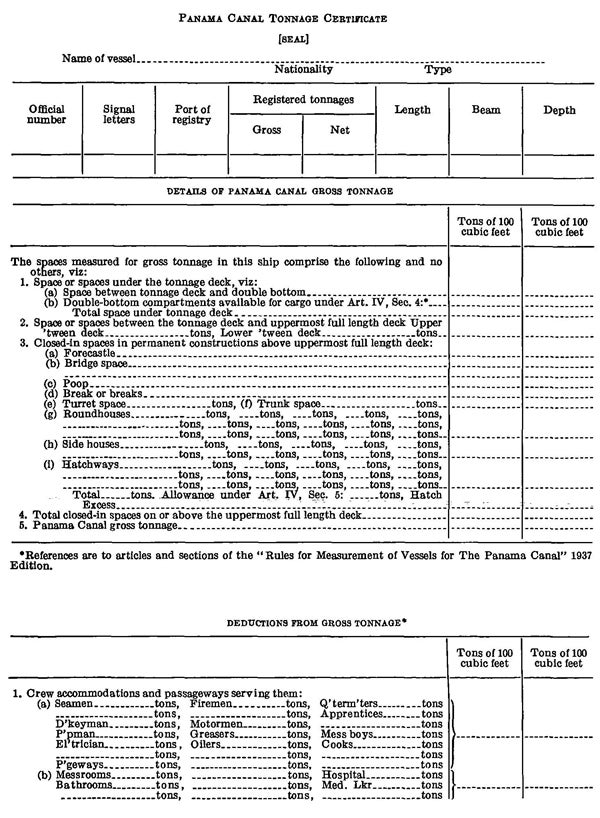
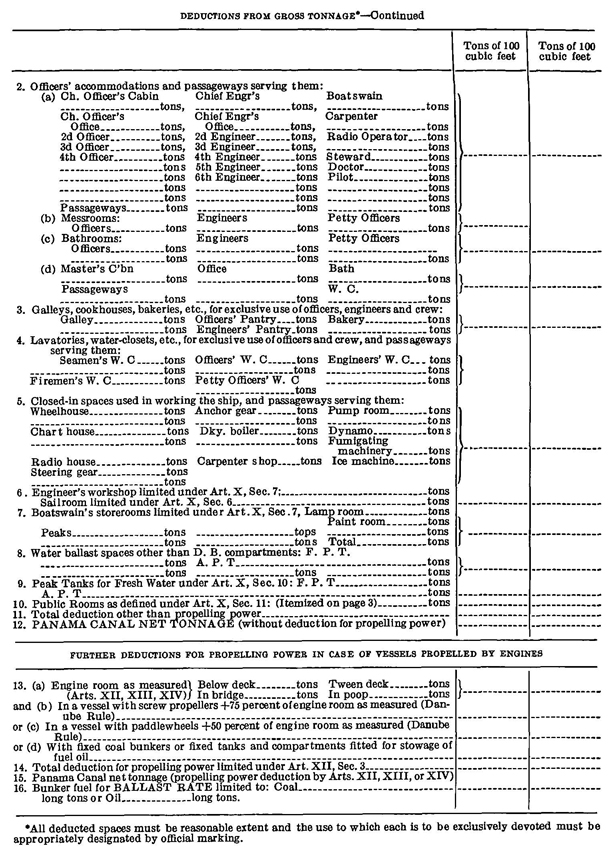
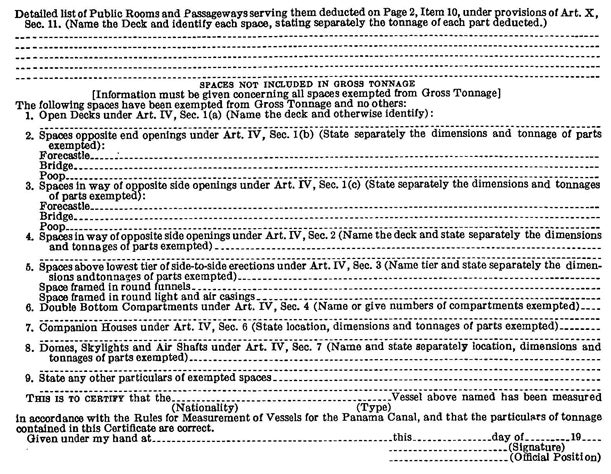
Related Images
Franklin D. Roosevelt, Proclamation 2248—Rules for the Measurement of Vessels for the Panama Canal Online by Gerhard Peters and John T. Woolley, The American Presidency Project https://www.presidency.ucsb.edu/node/357476

